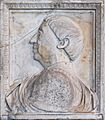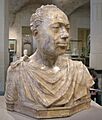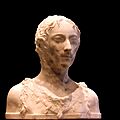Mino da Fiesole facts for kids
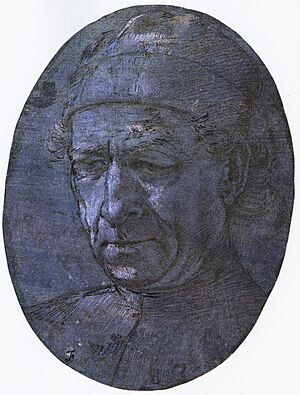
Mino da Fiesole (born around 1429 – died July 11, 1484) was a famous Italian Renaissance sculptor from a town called Poppi in Tuscany. He was also known as Mino di Giovanni. He is especially well-known for his detailed portrait busts, which are sculptures of people's heads and shoulders.
Contents
Mino's Sculpting Journey
Mino's artistic style was shaped by his teacher, Desiderio da Settignano, and another sculptor named Antonio Rossellino. His sculptures often show clothing (called drapery) with sharp, clear lines. Unlike many other sculptors from Florence at that time, Mino spent two long periods living and working in Rome. The first time was from about 1459 to 1464, and then again from about 1473 or 1474 until 1480.
Mino was a good friend and worked alongside Desiderio da Settignano and Matteo Civitali. All three sculptors were about the same age. Mino's sculptures are admired for how well they are made and for their delicate details. They also show a strong sense of faith and deep feeling.
Early Works and Important Commissions
Some of Mino's earliest and best works can be found in the cathedral of Fiesole. These include an altarpiece (a piece of art behind an altar) and the tomb of Bishop Leonardo Salutati, who died in 1466.
His most challenging and complex projects were an altarpiece and tombs for the church of the Benedictine monastery in Florence, known as the Badia. These monuments have been moved and set up again in the rebuilt church. The first project, finished around 1468, was for a Florentine lawyer named Bernardo Giugni.
The second project was directly asked for by the monks and finished in 1481. It honored the memory of their founder, Ugo, count of Tuscany, who lived in the tenth century. These wall monuments really showed off Mino's skills. He included portraits and bas-reliefs (sculptures that stick out slightly from a flat surface) within complex structures. These structures had very detailed and unique decorative carvings.
Art historians have found that Mino used many different ideas from both his own time and ancient times for these tombs. This made his work stand out from other sculptors working in Florence in the mid-1400s.
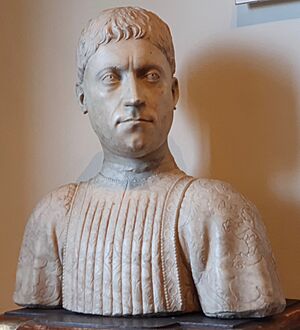
Mino also worked with Antonio Rossellino on the pulpit (a raised platform for speaking) in Prato Cathedral. This was finished in 1473. It has very finely sculpted bas-reliefs, but some people think the overall design is a bit weak.
Works in Rome
In 1473, Mino traveled to Rome and stayed there for about six years. It's not certain that all the monuments in Rome said to be by him were actually made by his own hands. However, there is no doubt about the tomb of the Florentine Francesco Tornabuoni in the Church of Santa Maria sopra Minerva. Also, parts of the monument to Pope Paul II in the crypt (an underground room) of St. Peter's are his. The beautiful small marble tabernacle (a container for holy items) for holy oils in St. Maria in Trastevere has his name carved on it: Opus Mini (meaning "Work of Mino").
Some monuments in Santa Maria del Popolo have sometimes been thought to be by Mino, such as the marble reredos (a screen or decoration behind an altar) given by Pope Alexander VI. However, the monuments there for Archbishop of Salerno Pietro Guglielmo Rocca (who died in 1482) and Bishop of Burgos Ortega Gomiel (who died in 1514) have also been linked to the style of Andrea Bregno.
Portrait Busts and Other Sculptures
Some of Mino's portrait busts and profile bas-reliefs (side-view sculptures) are kept in the Bargello museum in Florence. These works are full of life and expression. However, they are not as extremely realistic as the works of sculptors like Verrocchio from the same time.
Several museums around the world have Mino's artwork. These include the Musée du Louvre in Paris, France, the Museum of Fine Arts in Boston, Massachusetts, the Birmingham Museum of Art in Birmingham, Alabama, and the National Gallery of Art in Washington, D.C.
Here are some of his other important works:
- A portrait bust of Piero de Medici (1453). This is special because it's known as "the oldest confirmed example we have of a post-classical portrait of a living person made as a marble bust."
- A portrait bust of Niccolò Strozzi (1454).
- A bust of Astorgio Manfredi (1455).
- The ciborium (a canopy or container) over the main altar of Santa Maria Maggiore in Rome.
- A bust of Diotisalvi Neroni], who was an adviser to Piero de Medici (1464).
- Two sculptures called Charity and Faith. These were most likely made for a wall tomb (between 1475 and 1480).
Giorgio Vasari wrote about Mino da Fiesole in his famous book, Lives of the Artists. Vasari thought Mino was just a follower of his teacher, Desiderio da Settignano.
Images for kids
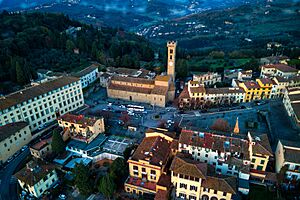
Gallery
-
Tomb of Ugo, count of Tuscany, at the Badia in Florence.
-
A sculpture of Alfonso V of Aragon.
-
A sculpture of Scipio Africanus made around 1460-1465, now at the Philadelphia Museum of Art.
-
Virgin Annunciate made around 1455-1460, now at the National Gallery of Art, Washington, D.C.
-
Madonna and Child at Château de Chenonceau, France.
-
Madonna and Child at the Louvre, France.
See also
- Master of the Marble Madonnas



